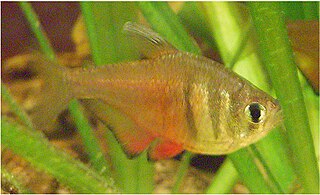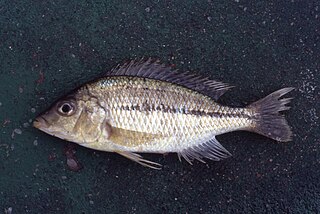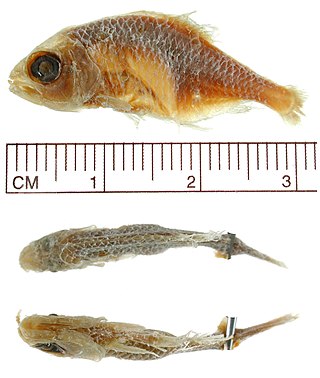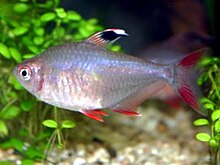
The black neon tetra is a freshwater fish of the characin family (Characidae) of the order Characiformes. It is native to the Paraguay basin of southern Brazil. They are often found in the aquarium trade.

The Buenos Aires tetra is a tropical fish from South America. It was first observed in the wild in 1907, by Carl H. Eigenmann.

Hyphessobrycon columbianus is a species of Tropical freshwater fish of the characin family. The Colombian tetra is native to the Acandi River near Acandí) in northwestern Colombia. The Colombian tetra's habitat tends to be slow-flowing creeks and tributaries.

Thayeria boehlkei is a species of characin fish endemic to the Amazon River basin and Araguaia River, in Peru and Brazil respectively. The species is popular with aquarium hobbyists where it is traded under a variety of common names including blackline penguinfish, blackline thayeria, hockey-stick tetra, penguin fish and penguin tetra.

The diamond tetra is a small freshwater fish of the characin family of order Characiformes. It is found in and around Lake Valencia in Venezuela, South America.

The flame tetra, also known as the red tetra or Rio tetra, is a small freshwater fish of the characin family Characidae. This tetra was first introduced as aquarium fish in 1920 by C. Bruening, Hamburg, Germany, and formally described in 1924 by Dr. George S. Myers. Today large numbers are bred in captivity and it is common in the aquarium trade, but the remaining wild population in Southeast Brazil is highly threatened.
George Sprague Myers was an American ichthyologist who spent most of his career at Stanford University. He served as the editor of Stanford Ichthyological Bulletin as well as president of the American Society of Ichthyologists and Herpetologists. Myers was also head of the Division of Fishes at the United States National Museum, and held a position as an ichthyologist for the United States Fish and Wildlife Service. He was also an advisor in fisheries and ichthyology to the Brazilian Government.

Protomelas kirkii is a species of cichlid endemic to Lake Malawi, where it is most commonly found in areas vegetated with Vallisneria. This species can reach a length of 18 centimetres (7.1 in) TL. It can also be found in the aquarium trade.

The ember tetra is a freshwater fish of the characin family of order Characiformes. It is native to the Araguaia River basin of Brazil and was discovered in 1987 and named in honor of the fish explorer Heiko Bleher's mother.

Nematobrycon palmeri, commonly known as the emperor tetra, is a species of characid fish found in the Atrato and San Juan river basins in western Colombia. It was first imported in the aquarium trade to the United States in 1960 and has since become well established.
Hyphessobrycon heterorhabdus, commonly known as the flag tetra or Belgian flag tetra, is a species of freshwater characin fish endemic to Brazil. Belonging to the family Characidae, this species is distinguished by its vibrant coloration and patterns, which have contributed to its popularity in the aquarium trade.

The rosy tetra is a small species of characin from the South American countries of Guyana and Suriname. It is popular in the aquarium trade.

The Costello tetra is a species of characin from the Amazon basin and is found in Brazil and Peru. The specific name comes from Lake Hyanuary in Brazil. Other common names used in English are January tetra and green neon. The name "green neon" is also used for Paracheirodon simulans.

The royal tetra is a species of characin endemic to Brazil, where it is found in tributaries of the Aripuanã River. It was once the sole member of its genus.

Petitella bleheri is a species of characin found in Amazon Basin in Brazil and Peru. It is one of three species commonly referred to as the rummy-nose tetra, and is also known as the firehead tetra.

Hyphessobrycon agulha is a species of tetra in the family Characidae. As a freshwater fish, it inhabits the basin of the Madeira River in Brazil along with parts of Peru and Bolivia, and it reaches a maximum length of 4.3 centimetres (1.7 in). Though it is mainly found in the wild, it is occasionally kept by fishkeepers and is sometimes confused with the neon tetra. The fish is primarily an insectivore, though it does eat vegetable matter. It is considered to form a group with other species in Hyphessobrycon as they share a dark stripe running lengthwise.
Hyphessobrycon axelrodi is a species of tetra in the family Characidae.

Hyphessobrycon boulengeri is a species of tetra belonging to the family charicidae. It is native to South America. It inhabits the Rio Grande do Sul, Brazil.

Scatophagus tetracanthus, the scatty or African scat is a species of ray-finned fish belonging to the family Scatophagidae, the scats. It is found in eastern Africa and Madagascar and in New Guinea and northern Australia.
Hyphessobrycon copelandi is a species of South American tetra, belonging to the family Characidae. They are gray in coloration with a faint black humeral spot. Their dorsal, pectoral, and anal fins are white fronted. It is known to reach a length of 3.5 centimetres (1.4 in). Hyphessobrycon copelandi is known to live in the Solimões, Mana, and Approuague River Basins. It is most often found in slow moving waters or areas in creeks with a counter current. It inhabits the upstream part of the river before waterfalls. They have seen limited use in the fish trade, even having a common name in German, federsalmler, which translates to "feather tetra". As a benthopelagic fish, they reside away from the surface of the water.

















